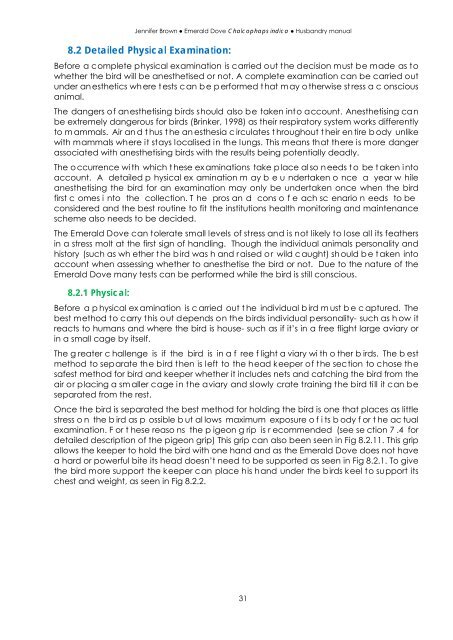Emerald Dove Husbandry Manual - Nswfmpa.org
Emerald Dove Husbandry Manual - Nswfmpa.org
Emerald Dove Husbandry Manual - Nswfmpa.org
Create successful ePaper yourself
Turn your PDF publications into a flip-book with our unique Google optimized e-Paper software.
Jennifer Brown ● <strong>Emerald</strong> <strong>Dove</strong> Chalcophaps indica ● <strong>Husbandry</strong> manual<br />
8.2 Detailed Physical Examination:<br />
Before a complete physical examination is carried out the decision must be made as to<br />
whether the bird will be anesthetised or not. A complete examination can be carried out<br />
under an esthetics wh ere t ests c an b e p erformed t hat m ay o therwise st ress a c onscious<br />
animal.<br />
The dangers of anesthetising birds should also be taken into account. Anesthetising can<br />
be extremely dangerous for birds (Brinker, 1998) as their respiratory system works differently<br />
to m ammals. Air an d t hus t he an esthesia c irculates t hroughout t heir en tire b ody unlike<br />
with mammals where it stays localised in the lungs. This means that there is more danger<br />
associated with anesthetising birds with the results being potentially deadly.<br />
The o ccurrence wi th which t hese ex aminations take p lace al so n eeds t o be t aken i nto<br />
account. A detailed p hysical ex amination m ay b e u ndertaken o nce a year w hile<br />
anesthetising the bird for an examination may only be undertaken once when the bird<br />
first c omes i nto the collection. T he pros an d cons o f e ach sc enario n eeds to be<br />
considered and the best routine to fit the institutions health monitoring and maintenance<br />
scheme also needs to be decided.<br />
The <strong>Emerald</strong> <strong>Dove</strong> can tolerate small levels of stress and is not likely to lose all its feathers<br />
in a stress molt at the first sign of handling. Though the individual animals personality and<br />
history (such as wh ether t he b ird was h and r aised o r wild c aught) sh ould b e t aken into<br />
account when assessing whether to anesthetise the bird or not. Due to the nature of the<br />
<strong>Emerald</strong> <strong>Dove</strong> many tests can be performed while the bird is still conscious.<br />
8.2. 1 Physical:<br />
Before a p hysical ex amination is c arried out t he individual b ird m ust b e c aptured. The<br />
best method to carry this out depends on the birds individual personality- such as h ow it<br />
reacts to humans and where the bird is house- such as if it’s in a free flight large aviary or<br />
in a small cage by itself.<br />
The g reater c hallenge is if the bird is in a f ree f light a viary wi th o ther b irds. The b est<br />
method to separate the bird then is left to the head keeper of the section to chose the<br />
safest method for bird and keeper whether it includes nets and catching the bird from the<br />
air or placing a sm aller cage in the aviary and slowly crate training the bird till it can be<br />
separated from the rest.<br />
Once the bird is separated the best method for holding the bird is one that places as little<br />
stress o n the b ird as p ossible b ut al lows maximum exposure o f i ts b ody f or t he ac tual<br />
examination. F or t hese reaso ns the p igeon g rip is r ecommended (see se ction 7 .4 for<br />
detailed description of the pigeon grip) This grip can also been seen in Fig 8.2.11. This grip<br />
allows the keeper to hold the bird with one hand and as the <strong>Emerald</strong> <strong>Dove</strong> does not have<br />
a hard or powerful bite its head doesn’t need to be supported as seen in Fig 8.2.1. To give<br />
the bird more support the keeper can place his hand under the birds keel to support its<br />
chest and weight, as seen in Fig 8.2.2.<br />
31

















